Experimental/Numerical Acoustic Assessment of Aircraft Seat Headrests Based on Electrospun Mats
Abstract
:1. Introduction
2. Experimental Campaign
3. Numerical Simulations
4. Results and Discussion
- There are some improvements provided by the PVP nanofiber insertions for almost all the configurations in the range 800–1400 Hz, whereas no differences are observed when the monopole source is positioned at 90 deg.
- No significant effect of modifications of both headrest geometry and cover textile is noticeable below 600 Hz. This can be attributed to the fact that at such low frequencies the acoustic wavelengths are larger than the largest headrest size; therefore, no significant alterations in the sound field can be achieved by modifying the headrest shape.
- Benefits of the different textiles and shapes on the SPL are lower when increasing the distance between the source and the headrest. Less benefits can be therefore expected when the acoustic sources are far from the headrest.
5. Conclusions
Author Contributions
Funding
Institutional Review Board Statement
Informed Consent Statement
Data Availability Statement
Acknowledgments
Conflicts of Interest
References
- Citarella, R.; Federico, L. Advances in Vibroacoustics and Aeroacustics of Aerospace and Automotive Systems. Appl. Sci. 2018, 8, 366. [Google Scholar] [CrossRef] [Green Version]
- Münzel, T.; Kröller-Schön, S.; Oelze, M.; Gori, T.; Schmidt, F.P.; Steven, S.; Hahad, O.; Röösli, M.; Wunderli, J.-M.; Daiber, A.; et al. Adverse Cardiovascular Effects of Traffic Noise with a Focus on Nighttime Noise and the New WHO Noise Guidelines. Annu. Rev. Public Heal. 2020, 41, 309–328. [Google Scholar] [CrossRef] [Green Version]
- Franssen, E.A.M.; Wiechen, C.M.A.G.V.; Nagelkerke, N.J.D.; Lebret, E. Aircraft noise around a large international airport and its impact on general health and medication use. Occup. Environ. Med. 2004, 61, 405–413. [Google Scholar] [CrossRef] [PubMed] [Green Version]
- Armentani, E.; Caputo, F.; Esposito, L.; Giannella, V.; Citarella, R. Multibody Simulation for the Vibration Analysis of a Turbocharged Diesel Engine. Appl. Sci. 2018, 8, 1192. [Google Scholar] [CrossRef] [Green Version]
- Armentani, E.; Giannella, V.; Parente, A.; Pirelli, M. Design for NVH: Topology optimization of an engine bracket support. Procedia Struct. Integr. 2020, 26, 211–218. [Google Scholar] [CrossRef]
- Citarella, R.; Landi, M. Acoustic analysis of an exhaust manifold by Indirect Boundary Element Method. Open Mech. Eng. J. 2011, 5, 138–151. [Google Scholar] [CrossRef] [Green Version]
- Armentani, E.; Trapani, R.; Citarella, R.; Parente, A.; Pirelli, M. FEM-BEM Numerical Procedure for Insertion Loss Assessment of an Engine Beauty Cover. Open Mech. Eng. J. 2013, 7, 27–34. [Google Scholar] [CrossRef]
- Barbarino, M.; Adamo, F.P.; Bianco, D.; Bartoccini, D. Hybrid BEM/empirical approach for scattering of correlated sources in rocket noise prediction. J. Sound Vib. 2017, 403, 90–103. [Google Scholar] [CrossRef]
- Armentani, E.; Giannella, V.; Citarella, R.; Parente, A.; Pirelli, M. Substructuring of a Petrol Engine: Dynamic Characterization and Experimental Validation. Appl. Sci. 2019, 9, 4969. [Google Scholar] [CrossRef] [Green Version]
- Barbarino, M.; Bianco, D. A BEM–FMM approach applied to the combined convected Helmholtz integral formulation for the solution of aeroacoustic problems. Comput. Methods Appl. Mech. Eng. 2018, 342, 585–603. [Google Scholar] [CrossRef]
- Bianco, D.; Adamo, F.P.; Barbarino, M.; Vitiello, P.; Bartoccini, D.; Federico, L.; Citarella, R. Integrated Aero–Vibroacoustics: The Design Verification Process of Vega-C Launcher. Appl. Sci. 2018, 8, 88. [Google Scholar] [CrossRef] [Green Version]
- Giannella, V.; Lombardi, R.; Pisani, M.M.; Federico, L.; Barbarino, M.; Citarella, R. A Novel Optimization Framework to Replicate the Vibro-Acoustics Response of an Aircraft Fuselage. Appl. Sci. 2020, 10, 2473. [Google Scholar] [CrossRef] [Green Version]
- Kirkup, S. The Boundary Element Method in Acoustics: A Survey. Appl. Sci. 2019, 9, 1642. [Google Scholar] [CrossRef] [Green Version]
- Yin, J.; Rossignol, K.-S.; Barbarino, M.; Bianco, D.; Testa, C.; Brouwer, H.; Janssen, S.R.; Reboul, G.; Vigevano, L.; Bernardini, G.; et al. GARTEUR activities on acoustical methods and experiments for studying on acoustic scattering. CEAS Aeronaut. J. 2018, 10, 531–551. [Google Scholar] [CrossRef]
- Brancati, A.; Aliabadi, M.H.; Mallardo, V. A BEM sensitivity formulation for three-dimensional active noise control. Int. J. Numer. Methods Eng. 2012, 90, 1183–1206. [Google Scholar] [CrossRef]
- Brancati, A.; Aliabadi, M. Boundary element simulations for local active noise control using an extended volume. Eng. Anal. Bound. Elements 2012, 36, 190–202. [Google Scholar] [CrossRef]
- Rajappan, S.; Bhaskaran, P.; Ravindran, P. An Insight into the Composite Materials for Passive Sound Absorption. J. Appl. Sci. 2017, 17, 339–356. [Google Scholar] [CrossRef]
- Khan, W.S.; Asmatulu, R.; Yildirim, M.B. Acoustical Properties of Electrospun Fibers for Aircraft Interior Noise Reduction. J. Aerosp. Eng. 2012, 25, 376–382. [Google Scholar] [CrossRef]
- Avossa, J.; Branda, F.; Marulo, F.; Petrone, G.; Guido, S.; Tomaiuolo, G.; Costantini, A. Light Electrospun Polyvinylpyrrolidone Blanket for Low Frequencies Sound Absorption. Chin. J. Polym. Sci. 2018, 36, 1368–1374. [Google Scholar] [CrossRef] [Green Version]
- Branda, F.; Marulo, F.; Guido, S.; Petrone, G.; Del Sorbo, G.R.; Truda, G.; Tomaiuolo, G. Polyvinylpyrrolidone (PVP)/Graphene based soundproofing materials through electrospinning. In Proceedings of the INTER-NOISE 2017—46th International Congress and Exposition on Noise Control Engineering: Taming Noise and Moving Quiet, Hong Kong Convention and Exhibition Centre (HKCEC), Hong Kong, China, 27–30 August 2017. [Google Scholar]
- Del Sorbo, G.R.; Truda, G.; Bifulco, A.; Passaro, J.; Petrone, G.; Vitolo, B.; Ausanio, G.; Vergara, A.; Marulo, F.; Branda, F. Non Monotonous Effects of Noncovalently Functionalized Graphene Addition on the Structure and Sound Absorption Properties of Polyvinylpyrrolidone (1300 kDa) Electrospun Mats. Materials 2019, 12, 108. [Google Scholar] [CrossRef] [Green Version]
- Giannella, V.; Branda, F.; Passaro, J.; Petrone, G.; Barbarino, M.; Citarella, R. Acoustic Improvements of Aircraft Headrests Based on Electrospun Mats Evaluated Through Boundary Element Method. Appl. Sci. 2020, 10, 5712. [Google Scholar] [CrossRef]
- Petrone, G.; Melillo, G.; Laudiero, A.; De Rosa, S. A Statistical Energy Analysis (SEA) model of a fuselage section for the prediction of the internal Sound Pressure Level (SPL) at cruise flight conditions. Aerosp. Sci. Technol. 2019, 88, 340–349. [Google Scholar] [CrossRef]
- Giannella, V.; Citarella, R.; Barbarino, M.; Vitiello, P.; Bianco, D.; Petrone, G. Passive Noise Control oriented design of aircraft headrests. In Proceedings of the INTER-NOISE 2019 MADRID—48th International Congress and Exhibition on Noise Control Engineering, Madrid, Spain, 16–19 June 2019. [Google Scholar]
- Mallardo, V.; Aliabadi, M.; Brancati, A.; Marant, V. An accelerated BEM for simulation of noise control in the aircraft cabin. Aerosp. Sci. Technol. 2012, 23, 418–428. [Google Scholar] [CrossRef]
- ESIGroup. VA One Users’ Guide; ESIGroup: Paris, France, 2019. [Google Scholar]
- Burton, A.J.; Miller, G.F. The application of integral equation methods to the numerical solution of some exterior boundary-value problems. In Proceedings of the Royal Society of London. A. Mathematical and Physical Sciences; The Royal Society: London, UK, 1971; Volume 323, pp. 201–210. [Google Scholar]



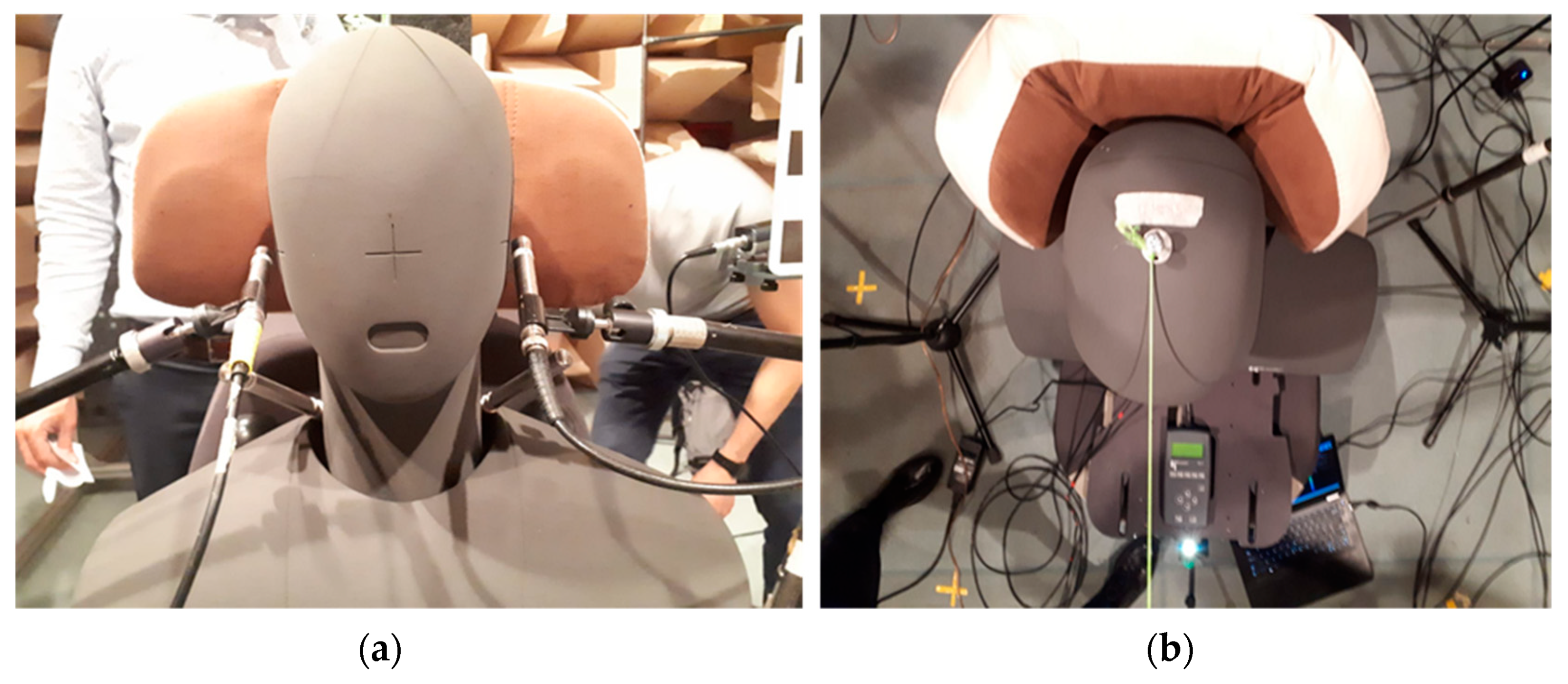
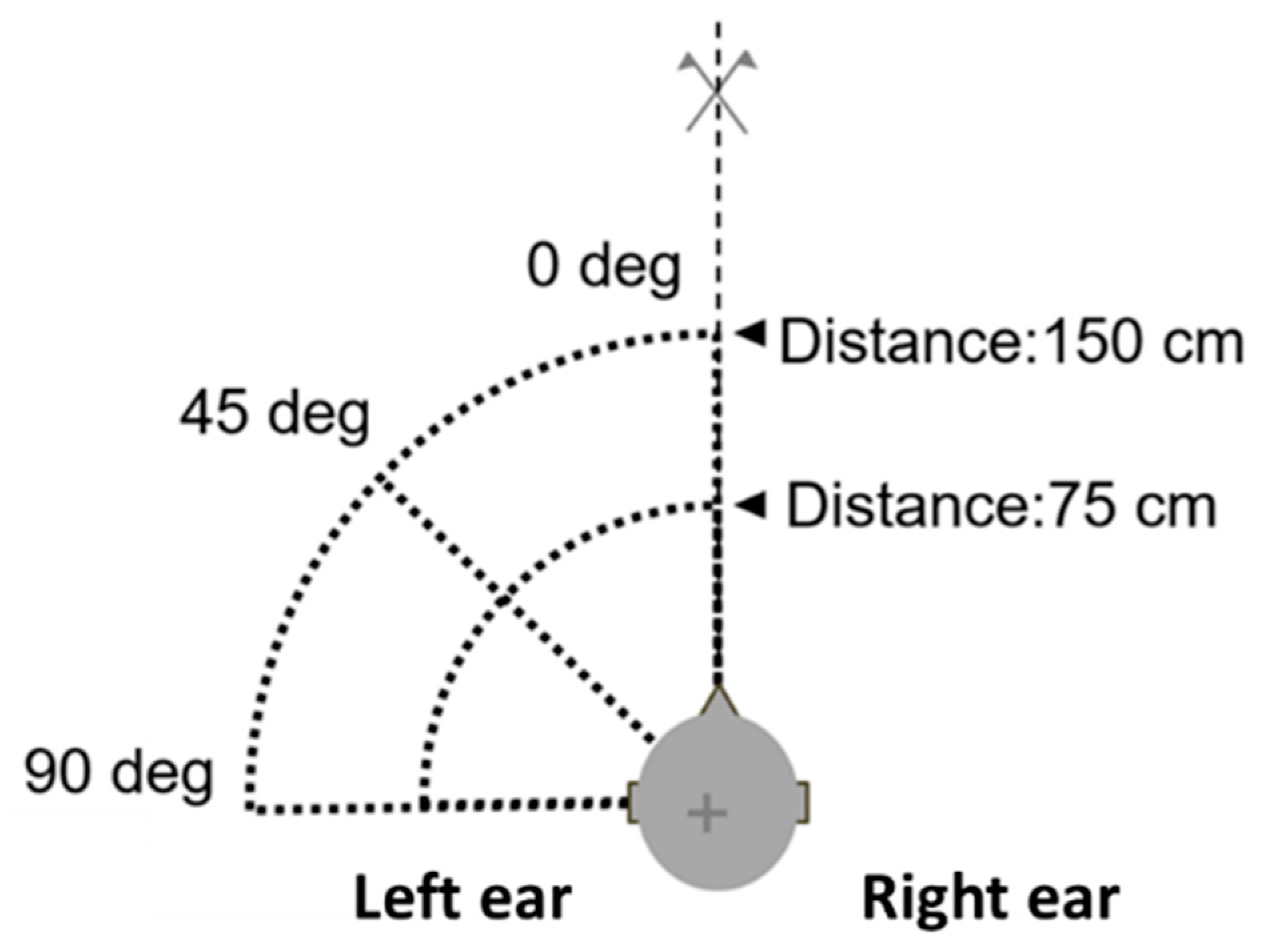
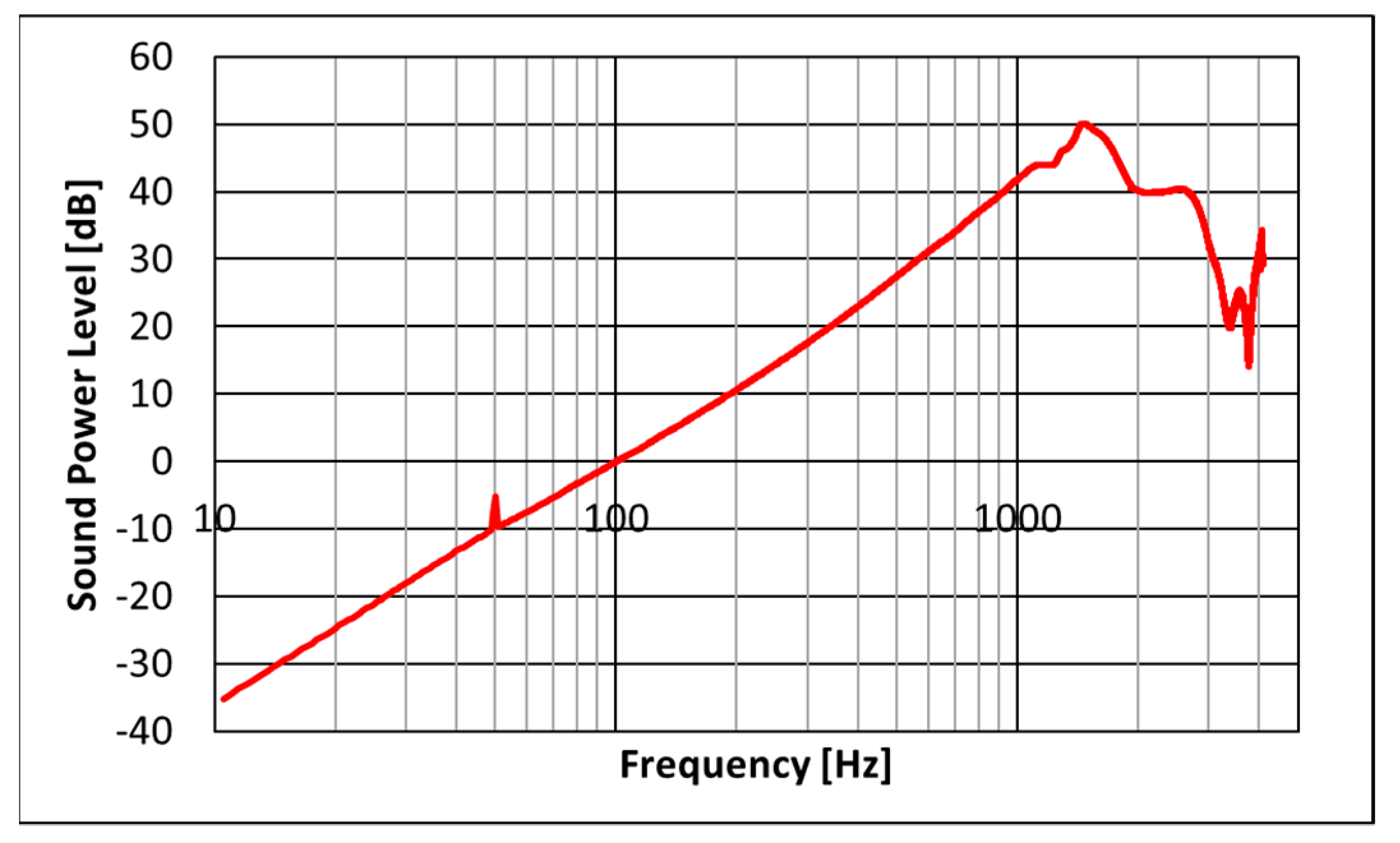

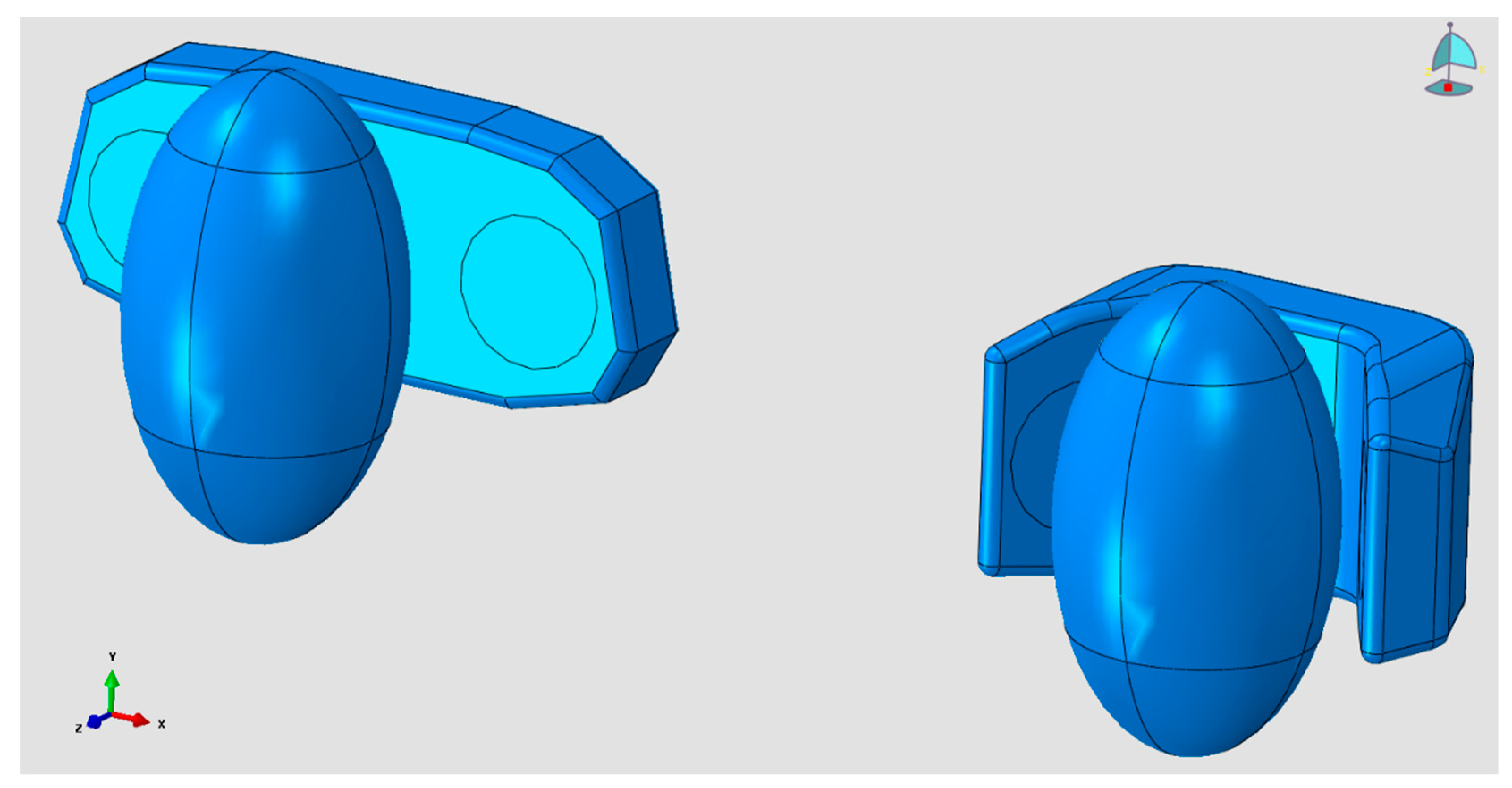
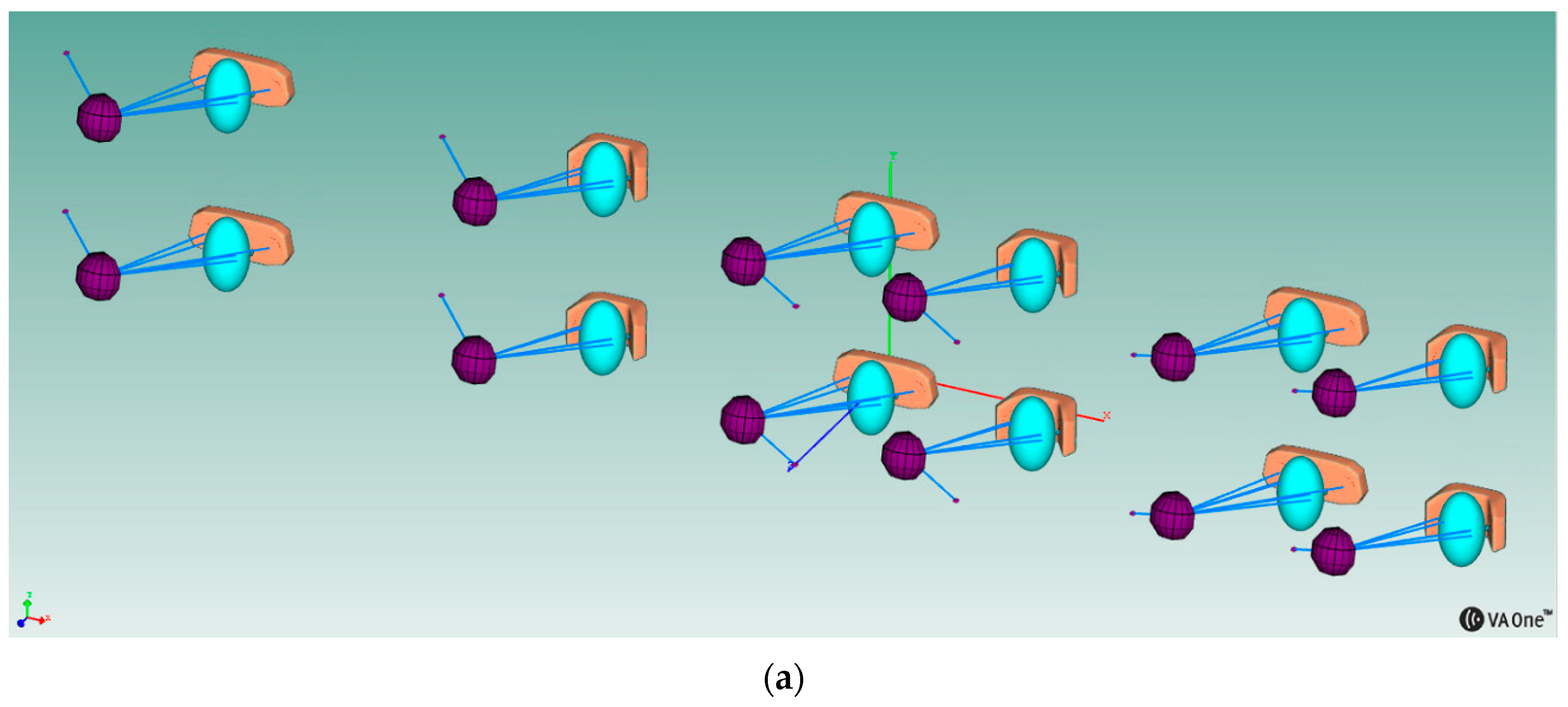
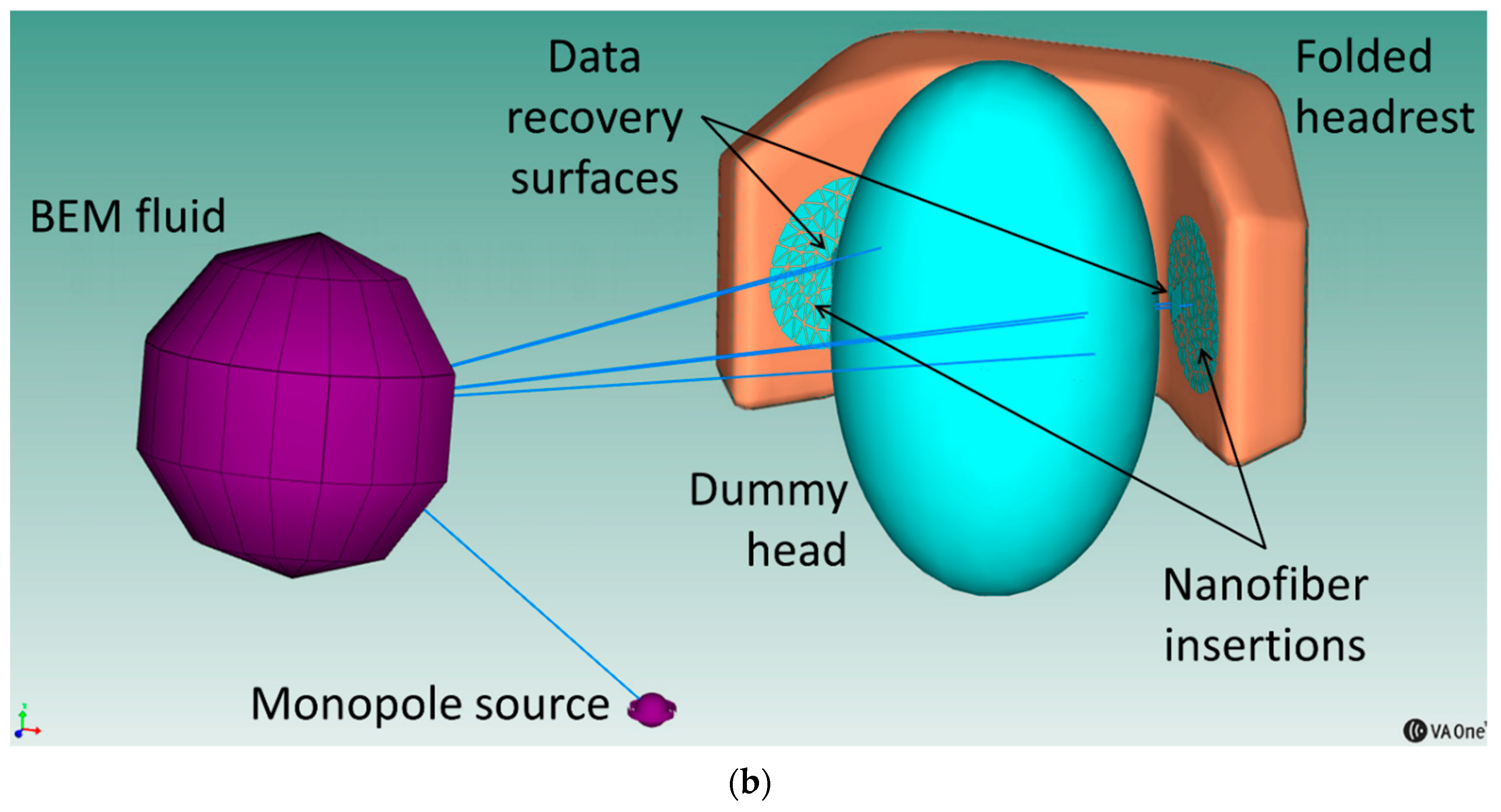

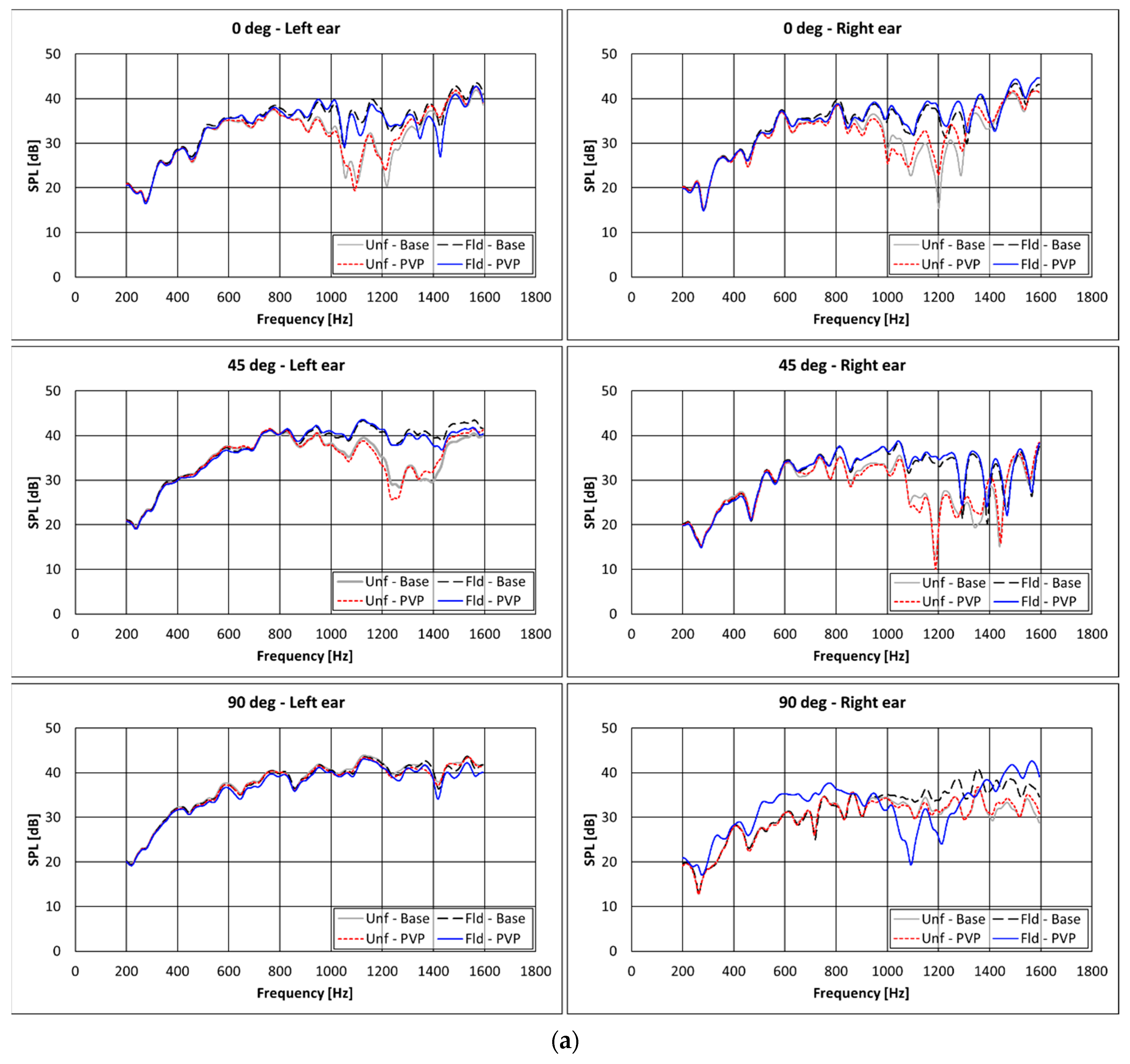
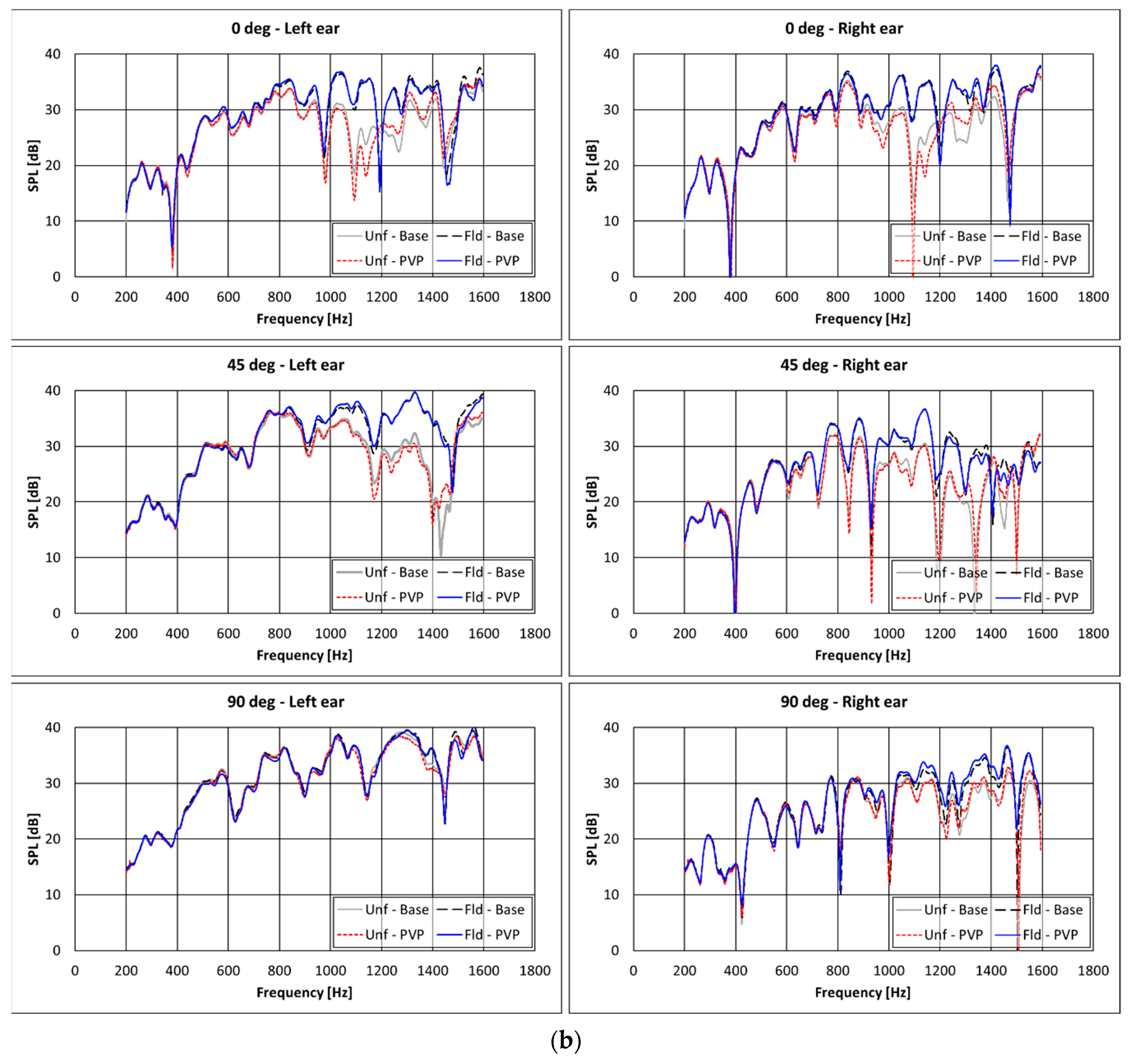

| Headrest Configuration | Shape | Distance [m] | Angle [°] |
|---|---|---|---|
| Baseline | Folded | 0.75 m | 0 |
| Baseline | Folded | 0.75 m | 45 |
| Baseline | Folded | 0.75 m | 90 |
| Baseline | Folded | 1.5 m | 0 |
| Baseline | Folded | 1.5 m | 45 |
| Baseline | Folded | 1.5 m | 90 |
| Baseline | Unfolded | 0.75 m | 0 |
| Baseline | Unfolded | 0.75 m | 45 |
| Baseline | Unfolded | 0.75 m | 90 |
| Baseline | Unfolded | 1.5 m | 0 |
| Baseline | Unfolded | 1.5 m | 45 |
| Baseline | Unfolded | 1.5 m | 90 |
| Insertion | Folded | 0.75 m | 0 |
| Insertion | Folded | 0.75 m | 45 |
| Insertion | Folded | 0.75 m | 90 |
| Insertion | Folded | 1.5 m | 0 |
| Insertion | Folded | 1.5 m | 45 |
| Insertion | Folded | 1.5 m | 90 |
| Insertion | Unfolded | 0.75 m | 0 |
| Insertion | Unfolded | 0.75 m | 45 |
| Insertion | Unfolded | 0.75 m | 90 |
| Insertion | Unfolded | 1.5 m | 0 |
| Insertion | Unfolded | 1.5 m | 45 |
| Insertion | Unfolded | 1.5 m | 90 |
| Baseline | Folded | 0.75 m | 0 |
| Baseline | Folded | 0.75 m | 45 |
| Baseline | Folded | 0.75 m | 90 |
| Baseline | Folded | 1.5 m | 0 |
| Baseline | Folded | 1.5 m | 45 |
| Baseline | Folded | 1.5 m | 90 |
| Baseline | Unfolded | 0.75 m | 0 |
| Baseline | Unfolded | 0.75 m | 45 |
| Baseline | Unfolded | 0.75 m | 90 |
| Baseline | Unfolded | 1.5 m | 0 |
| Baseline | Unfolded | 1.5 m | 45 |
| Baseline | Unfolded | 1.5 m | 90 |
Publisher’s Note: MDPI stays neutral with regard to jurisdictional claims in published maps and institutional affiliations. |
© 2021 by the authors. Licensee MDPI, Basel, Switzerland. This article is an open access article distributed under the terms and conditions of the Creative Commons Attribution (CC BY) license (https://creativecommons.org/licenses/by/4.0/).
Share and Cite
Giannella, V.; Colangeli, C.; Cuenca, J.; Citarella, R.; Barbarino, M. Experimental/Numerical Acoustic Assessment of Aircraft Seat Headrests Based on Electrospun Mats. Appl. Sci. 2021, 11, 6400. https://doi.org/10.3390/app11146400
Giannella V, Colangeli C, Cuenca J, Citarella R, Barbarino M. Experimental/Numerical Acoustic Assessment of Aircraft Seat Headrests Based on Electrospun Mats. Applied Sciences. 2021; 11(14):6400. https://doi.org/10.3390/app11146400
Chicago/Turabian StyleGiannella, Venanzio, Claudio Colangeli, Jacques Cuenca, Roberto Citarella, and Mattia Barbarino. 2021. "Experimental/Numerical Acoustic Assessment of Aircraft Seat Headrests Based on Electrospun Mats" Applied Sciences 11, no. 14: 6400. https://doi.org/10.3390/app11146400
APA StyleGiannella, V., Colangeli, C., Cuenca, J., Citarella, R., & Barbarino, M. (2021). Experimental/Numerical Acoustic Assessment of Aircraft Seat Headrests Based on Electrospun Mats. Applied Sciences, 11(14), 6400. https://doi.org/10.3390/app11146400









